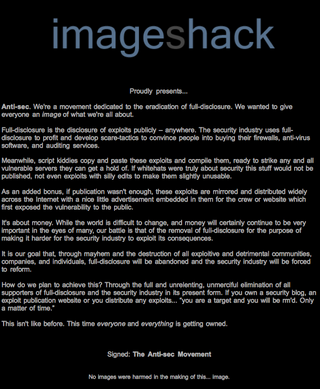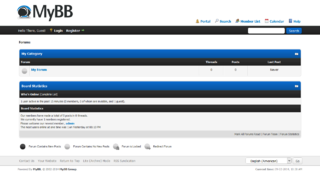Defensive programming is a form of defensive design intended to develop programs that are capable of detecting potential security abnormalities and make predetermined responses. It ensures the continuing function of a piece of software under unforeseen circumstances. Defensive programming practices are often used where high availability, safety, or security is needed.

Drupal is a free and open-source web content management system (CMS) written in PHP and distributed under the GNU General Public License. Drupal provides an open-source back-end framework for at least 14% of the top 10,000 websites worldwide and 1.2% of the top 10 million websites—ranging from personal blogs to corporate, political, and government sites. Drupal can also be used for knowledge management and for business collaboration.

phpBB is an Internet forum package written in the PHP scripting language. The name "phpBB" is an abbreviation of PHP Bulletin Board. Available under the GNU General Public License, phpBB is free and open-source.

In computing, a crash, or system crash, occurs when a computer program such as a software application or an operating system stops functioning properly and exits. On some operating systems or individual applications, a crash reporting service will report the crash and any details relating to it, usually to the developer(s) of the application. If the program is a critical part of the operating system, the entire system may crash or hang, often resulting in a kernel panic or fatal system error.

In computing, SQL injection is a code injection technique used to attack data-driven applications, in which malicious SQL statements are inserted into an entry field for execution. SQL injection must exploit a security vulnerability in an application's software, for example, when user input is either incorrectly filtered for string literal escape characters embedded in SQL statements or user input is not strongly typed and unexpectedly executed. SQL injection is mostly known as an attack vector for websites but can be used to attack any type of SQL database.
Uncontrolled format string is a type of code injection vulnerability discovered around 1989 that can be used in security exploits. Originally thought harmless, format string exploits can be used to crash a program or to execute harmful code. The problem stems from the use of unchecked user input as the format string parameter in certain C functions that perform formatting, such as printf . A malicious user may use the %s and %x format tokens, among others, to print data from the call stack or possibly other locations in memory. One may also write arbitrary data to arbitrary locations using the %n format token, which commands printf and similar functions to write the number of bytes formatted to an address stored on the stack.

Privilege escalation is the act of exploiting a bug, a design flaw, or a configuration oversight in an operating system or software application to gain elevated access to resources that are normally protected from an application or user. The result is that an application with more privileges than intended by the application developer or system administrator can perform unauthorized actions.
Elias Levy is a computer scientist. He was the moderator of "Bugtraq", a full disclosure vulnerability mailing list, from May 14, 1996 until October 15, 2001.
Code injection is the exploitation of a computer bug that is caused by processing invalid data. The injection is used by an attacker to introduce code into a vulnerable computer program and change the course of execution. The result of successful code injection can be disastrous, for example, by allowing computer viruses or computer worms to propagate.
Vulnerabilities are flaws in a computer system that weaken the overall security of the device/system. Vulnerabilities can be weaknesses in either the hardware itself, or the software that runs on the hardware. Vulnerabilities can be exploited by a threat actor, such as an attacker, to cross privilege boundaries within a computer system. To exploit a vulnerability, an attacker must have at least one applicable tool or technique that can connect to a system weakness. In this frame, vulnerabilities are also known as the attack surface. Constructs in programming languages that are difficult to use properly can also manifest large numbers of vulnerabilities.
Database security concerns the use of a broad range of information security controls to protect databases against compromises of their confidentiality, integrity and availability. It involves various types or categories of controls, such as technical, procedural or administrative, and physical.
Bugtraq was an electronic mailing list dedicated to issues about computer security. On-topic issues are new discussions about vulnerabilities, vendor security-related announcements, methods of exploitation, and how to fix them. It was a high-volume mailing list, with as many as 776 posts in a month, and almost all new security vulnerabilities were discussed on the list in its early days. The forum provided a vehicle for anyone to disclose and discuss computer vulnerabilities, including security researchers and product vendors. While the service has not been officially terminated, and its archives are still publicly accessible, no new posts have been made since January 2021.

The Anti Security Movement is a movement opposed to the computer security industry. Antisec is against full disclosure of information relating to software vulnerabilities, exploits, exploitation techniques, hacking tools, attacking public outlets and distribution points of that information. The general thought behind this is that the computer security industry uses full disclosure to profit and develop scare-tactics to convince people into buying their firewalls, anti-virus software and auditing services.
A vulnerability database (VDB) is a platform aimed at collecting, maintaining, and disseminating information about discovered computer security vulnerabilities. The database will customarily describe the identified vulnerability, assess the potential impact on affected systems, and any workarounds or updates to mitigate the issue. A VDB will assign a unique identifier to each vulnerability cataloged such as a number or alphanumeric designation. Information in the database can be made available via web pages, exports, or API. A VDB can provide the information for free, for pay, or a combination thereof.

H. D. Moore is a network security expert, open source programmer, and hacker. He is the founder of the Metasploit Project and was the main developer of the Metasploit Framework, a penetration testing software suite.
Teamp0ison was a computer security research group consisting of 3 to 5 core members. The group gained notoriety in 2011/2012 for its blackhat hacking activities, which included attacks on the United Nations, NASA, NATO, Facebook, Minecraft Pocket Edition Forums, and several other large corporations and government entities. TeaMp0isoN disbanded in 2012 following the arrests of some of its core members, "TriCk", and "MLT".

MyBB, formerly MyBBoard and originally MyBulletinBoard, is a free and open-source forum software developed by the MyBB Group. It is written in PHP, supports MySQL, PostgreSQL and SQLite as database systems and, in addition, has database failover support. It is available in multiple languages and is licensed under the LGPL. The software allows users to facilitate community driven interaction through a MyBB instance.

NullCrew was a hacktivist group founded in 2012 that took responsibility for multiple high-profile computer attacks against corporations, educational institutions, and government agencies.
The Java software platform provides a number of features designed for improving the security of Java applications. This includes enforcing runtime constraints through the use of the Java Virtual Machine (JVM), a security manager that sandboxes untrusted code from the rest of the operating system, and a suite of security APIs that Java developers can utilise. Despite this, criticism has been directed at the programming language, and Oracle, due to an increase in malicious programs that revealed security vulnerabilities in the JVM, which were subsequently not properly addressed by Oracle in a timely manner.
A bug bounty program is a deal offered by many websites, organizations, and software developers by which individuals can receive recognition and compensation for reporting bugs, especially those pertaining to security exploits and vulnerabilities.









